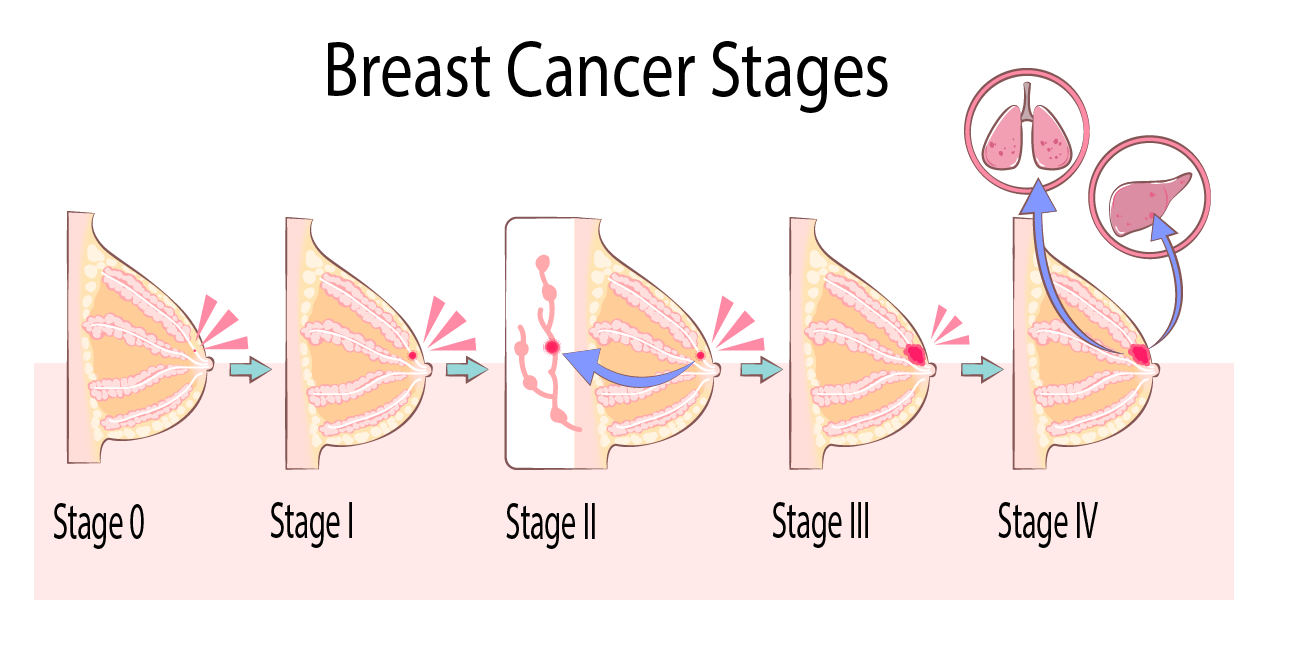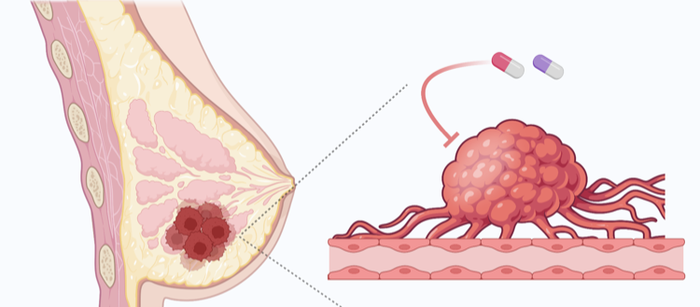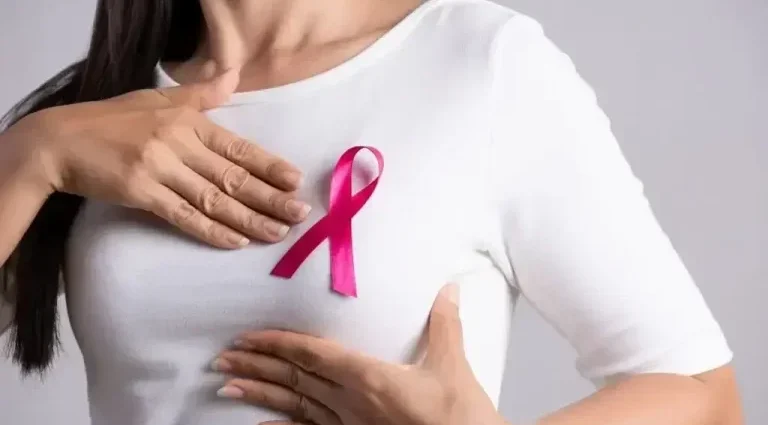Breast cancer remains one of the most prevalent forms of cancer among women worldwide, although it also affects a smaller percentage of men. It begins when cells in the breast grow out of control, forming a tumor that can often be seen on an X-ray or felt as a lump. Early detection and understanding of breast cancer are critical for managing and potentially overcoming the disease. This article aims to delve into the causes, symptoms, stages, and treatment options available for breast cancer patients. By bringing awareness and knowledge, individuals can take proactive steps towards prevention and early detection, significantly impacting the prognosis and treatment outcomes. With ongoing research and advancements in medicine, there is hope and support for those affected by breast cancer.
Causes of Breast Cancer:
Breast cancer’s exact causes aren’t universally defined, yet researchers have identified factors that increase an individual’s risk. These factors are generally split into two categories: genetic factors and lifestyle factors. Understanding these can provide insight into preventive measures or early detection strategies.
Genetic Factors
Genetic factors play a crucial role in the development of breast cancer. About 5% to 10% of breast cancer cases are thought to be hereditary, caused directly by gene mutations passed from parent to child. The most well-known of these mutations occur in the BRCA1 and BRCA2 genes. Individuals with these mutations have a significantly higher risk of developing breast cancer. Other genetic predispositions may involve genes such as PALB2, TP53, and CHEK2, among others. Family history is also a noteworthy risk factor; having a first-degree relative (mother, sister, or daughter) with breast cancer nearly doubles a woman’s risk of developing the disease. However, it’s important to note that many people diagnosed with breast cancer have no family history of the disease, indicating that genetic predisposition is just one facet of breast cancer causation.
Lifestyle Factors
Besides genetic predispositions, certain lifestyle factors are known to influence the risk of developing breast cancer. These include:
- Alcohol consumption: Regular alcohol consumption is linked to an increased risk of breast cancer. The risk rises with the amount of alcohol consumed.
- Obesity: Being overweight or obese, especially after menopause, has been found to increase breast cancer risk due to higher levels of estrogen produced by fat tissue.
- Physical inactivity: A sedentary lifestyle is another risk factor. Regular exercise is known to reduce breast cancer risk.
- Reproductive history: Women who have their first child after age 30, do not breastfeed, or never have a full-term pregnancy may have a higher risk. Additionally, starting menstruation before the age of 12 and entering menopause after age 55 expose women to hormones longer, raising the risk.
- Hormone replacement therapy: Prolonged use of hormone replacement therapy (HRT) and oral contraceptives have been associated with a slightly increased risk of breast cancer.
Understanding these factors can empower women to make informed decisions about their health. However, it’s important to note that having one or even several risk factors does not guarantee that a person will develop breast cancer. Moreover, many people who develop the disease have no clear risk factors.
Symptoms of Breast Cancer:
Early detection plays a pivotal role in the successful treatment of breast cancer. Recognition of the initial symptoms can lead to earlier diagnosis and, consequently, better outcomes. It is crucial for individuals to regularly perform breast self-examinations and report any changes or unusual findings to their healthcare provider.
Common Signs
The most common early sign of breast cancer is a new lump or mass in the breast that feels different from the surrounding tissue. Other common symptoms of breast cancer include:
- Change in the size, shape, or appearance of a breast: This may include dimpling, puckering, or bulging of the skin.
- Changes to the skin over the breast: Such as redness, pitting (skin resembling the surface of an orange), and flaking or peeling of the nipple skin.
- Nipple changes or discharge: This can include the nipple turning inward or discharge other than breast milk, sometimes containing blood.
- Pain: Although not as common, some individuals may experience breast pain or discomfort.
It’s important to understand that these symptoms can also be caused by conditions other than breast cancer. However, any new or unusual changes should prompt a visit to a healthcare provider for further evaluation.
Less Common Symptoms:
Some symptoms of breast cancer are less commonly experienced but are equally important to recognize. These include:
- Swelling in the lymph nodes: Particularly those in the armpit or collarbone area, even before a noticeable lump in the breast.
- Irritation or itchy breasts: While this can often be due to other non-cancerous conditions, persistent itching warrants medical examination.
- Changes in breast color: Unusual redness or darkening.
- Increased breast tenderness: Particularly if linked to the menstrual cycle.
- Visible veins on the breast: An increase in the visibility of the veins can indicate an underlying issue.
Keeping vigilant about any changes in one’s body is the first step toward early detection of breast cancer. Regular mammograms and professional screenings are also essential components of a comprehensive breast health strategy, particularly for those at higher risk due to genetic factors or lifestyle choices.
Stages of Breast Cancer

Understanding the stages of breast cancer is crucial for determining the most appropriate treatment strategy. Breast cancer stages range from 0, indicating non-invasive cancers, to IV, which refers to cancer that has spread beyond the breast and nearby lymph nodes to other parts of the body. The staging system, developed by the American Joint Committee on Cancer, utilizes the TNM system: Tumor size (T), Node involvement (N), and Metastasis (M).\
Stage 0: Ductal Carcinoma in Situ (DCIS)
Stage 0 breast cancer, also known as Ductal Carcinoma in Situ (DCIS), is a non-invasive condition. In DCIS, the cancer cells are confined within the ducts of the breast and have not invaded surrounding breast tissue. This stage is highly treatable and is often discovered during mammography screenings. Treatment options for DCIS typically include surgery to remove the cancerous cells, and in some cases, radiation therapy. The outlook for individuals diagnosed at this stage is generally excellent, with high survival rates.
Stage I-IV
As breast cancer progresses from Stage I to IV, it becomes more advanced, with increasing involvement of lymph nodes and the potential for spread to distant organs.
Stage I: At this initial stage, the tumor is small (up to 2 cm) and may or may not have spread to nearby lymph nodes. The cancer at this point is invasive, meaning it has begun to spread to surrounding breast tissue. Treatment often involves surgery and possibly radiation, with a very good prognosis.
Stage II: This stage is characterized by larger tumors (2-5 cm) or cancer spreading to 1-3 axillary (underarm) lymph nodes. Treatment typically includes surgery, radiation, and systemic therapies like chemotherapy, hormone therapy, or targeted therapy depending on the cancer’s specific characteristics.
Stage III: Often referred to as locally advanced breast cancer, Stage III means the tumor is larger than 5 cm or the cancer has spread to more than three lymph nodes but not to distant parts of the body. Treatment may involve neoadjuvant therapy (treatment given before the main treatment) to shrink the tumor before surgery, followed by radiation and additional systemic therapy.
Stage IV: This is the most advanced stage of breast cancer, indicating that the cancer has spread beyond the breast and nearby lymph nodes to other parts of the body such as the bones, liver, lungs, or brain. Stage IV breast cancer is considered incurable, but treatment can extend and improve quality of life. Treatments include systemic therapies, targeted treatments, radiation, and surgery to manage symptoms.
The progression from Stage I through IV indicates a gradual increase in the cancer’s spread and severity. It’s crucial to understand that the choice of treatment depends on the stage at diagnosis, the tumor’s characteristics, and the patient’s overall health and preferences. Early detection through regular screenings is vital for identifying breast cancer at an earlier, more treatable stage.
Treatment Options for Breast Cancer:

Breast cancer treatment varies greatly and is often tailored to the specific type of cancer and its stage. Understanding the primary treatment options available can provide insight into the journey ahead for patients and their families.
- Surgery
Surgery is a common treatment for breast cancer, aimed at removing the tumor. There are several types of surgeries, such as lumpectomy, where only the tumor and a small margin of surrounding tissue are removed, and mastectomy, where one or both breasts are removed. The choice between these depends on the stage of cancer, size of the tumor, personal preference, and overall health of the patient.
- Chemotherapy
Chemotherapy involves using drugs to kill cancer cells and is often employed before surgery (neoadjuvant chemotherapy) to shrink tumors or after surgery (adjuvant chemotherapy) to eliminate any remaining cancer cells. Chemotherapy can also be used as the main treatment for cancers that have spread beyond the breast and lymph nodes. Side effects vary and depend on the type and dose of drugs used.
- Radiation Therapy
Radiation therapy uses high-energy waves to target and destroy cancer cells. This treatment is commonly used after surgery to eliminate any leftover cancer cells in the breast, chest wall, or axilla (armpit area) to minimize the risk of recurrence. It’s mainly recommended for patients who have had a lumpectomy, to kill any undetected cancer cells, and for those with a larger tumor or cancer that has spread to the lymph nodes.
- Hormone Therapy
Hormone therapy is effective for types of breast cancer that are hormone receptor-positive. These cancers grow in response to hormones like estrogen or progesterone. Treatments can include medications that block the body’s natural hormones from supporting the growth of cancer cells or medications that lower hormone levels in the body. This therapy helps prevent the recurrence of breast cancer and is often used after other treatments.
- Targeted Therapy
Targeted therapy is a newer form of cancer treatment that specifically targets the molecular markers that distinguish cancer cells from normal cells. This method allows for a more precise attack on cancer cells while minimizing damage to healthy cells. Examples include drugs that target HER2-positive breast cancers, a type of cancer that tests positive for a protein called human epidermal growth factor receptor 2, which promotes the growth of cancer cells. Targeted therapies can have fewer side effects compared to chemotherapy and radiation but are not suitable for all types of breast cancer.

